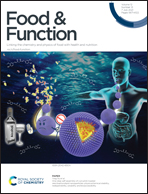Germinated millet flour (Pennisetum glaucum (L.) R. BR.) improves adipogenesis and glucose metabolism and maintains thyroid function in vivo
Abstract
This study investigated the effects of germinated millet flour on adipogenesis, insulin resistance, glucose tolerance and thyroid function in Wistar rats fed with a high-fat high-fructose diet (HFHF). The experiment was divided into two phases. Phase 1: control group, which received an AIN-93M diet (n = 10) and HFHF group (n = 20), which received a diet rich in saturated fat (31%) and fructose (20%), for eight weeks. Phase 2: intervention: the control group maintained the AIN-93M diet (n = 10) and the HFHF group was divided into two groups: the HFHF (n = 10) and the germinated millet group (n = 10), for 10 weeks. The germinated millet flour maintained (p > 0, 05) the plasma levels of thyroid hormones, increased (p < 0.05) the insulin receptor (INSR) mRNA expression, protein kinase B (AKT) mRNA expression and the phospho-AKT1 protein concentration, phosphofructokinase (PFK) mRNA, pyruvate kinase (PK) mRNA and activated protein kinase (AMPK) mRNA expression, and the brown adipose tissue and reduced (p < 0.05) the glucose triglyceride index (TyG), glucose, insulin, HOMA-IR and hypercorticosteronemia, compared to the HFHF group. These effects contributed to reduce the gluconeogenesis, hyperinsulinemia and adiposity. Thus, germinated millet flour is a good alternative for modulating the adipogenesis and glucose metabolism, without interfering with the thyroid hormones, in rats with an insulin resistance condition with a high-fat high-fructose diet.



 Please wait while we load your content...
Please wait while we load your content...